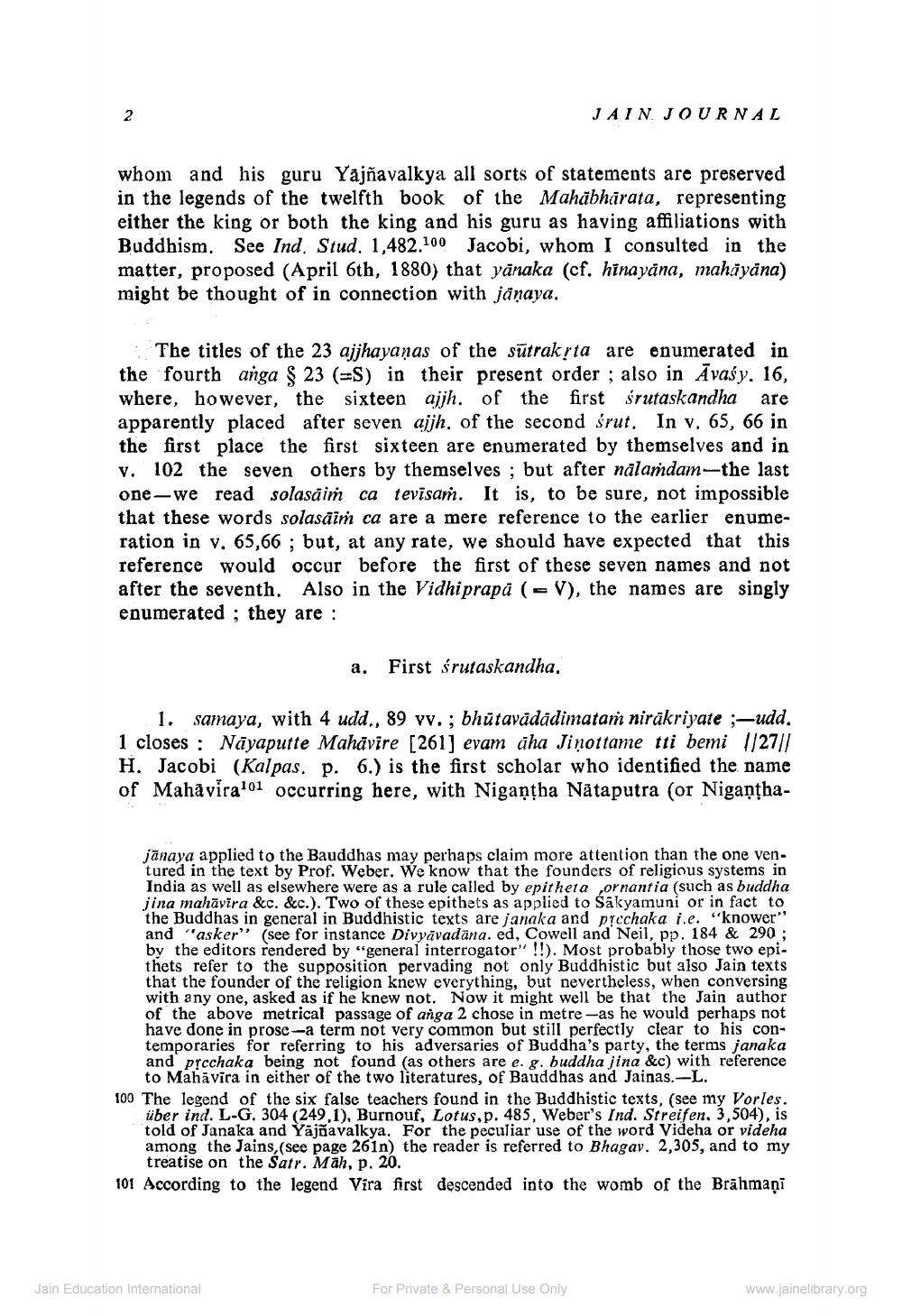Book Title: Jain Journal 1992 07 Author(s): Jain Bhawan Publication Publisher: Jain Bhawan Publication View full book textPage 7
________________ 2 whom and his guru Yajnavalkya all sorts of statements are preserved in the legends of the twelfth book of the Mahabharata, representing either the king or both the king and his guru as having affiliations with Buddhism. See Ind. Stud. 1,482.100 Jacobi, whom I consulted in the matter, proposed (April 6th, 1880) that yānaka (cf. hinayana, mahāyāna) might be thought of in connection with jāṇaya. The titles of the 23 ajjhayaņas of the sutrakṛta are enumerated in the fourth anga § 23 (-S) in their present order; also in Avasy. 16, where, however, the sixteen ajjh. of the first śrutaskandha are apparently placed after seven ajjh, of the second śrut. In v. 65, 66 in the first place the first sixteen are enumerated by themselves and in v. 102 the seven others by themselves; but after nalamdam-the last one-we read solasaim ca tevisam. It is, to be sure, not impossible that these words solasaim ca are a mere reference to the earlier enumeration in v. 65,66; but, at any rate, we should have expected that this reference would occur before the first of these seven names and not after the seventh. Also in the Vidhiprapa (V), the names are singly enumerated; they are: JAIN JOURNAL a. First śrutaskandha. 1. samaya, with 4 udd., 89 vv. ; bhutavādāädimatam nirākriyate ;-udd. 1 closes Nayaputte Mahavire [261] evam aha Jinottame tti bemi ||27|| H. Jacobi (Kalpas. p. 6.) is the first scholar who identified the name of Mahavira101 occurring here, with Nigantha Nataputra (or Nigaṇṭha janaya applied to the Bauddhas may perhaps claim more attention than the one ventured in the text by Prof. Weber. We know that the founders of religious systems in India as well as elsewhere were as a rule called by epitheta,ornantia (such as buddha jina mahavira &c. &c.). Two of these epithets as applied to Sakyamuni or in fact to the Buddhas in general in Buddhistic texts are janaka and prcchaka i.e. "knower" and "asker" (see for instance Divyavadana. ed, Cowell and Neil, pp. 184 & 290; by the editors rendered by "general interrogator" !!). Most probably those two epithets refer to the supposition pervading not only Buddhistic but also Jain texts that the founder of the religion knew everything, but nevertheless, when conversing with any one, asked as if he knew not. Now it might well be that the Jain author of the above metrical passage of anga 2 chose in metre-as he would perhaps not have done in prose-a term not very common but still perfectly clear to his contemporaries for referring to his adversaries of Buddha's party, the terms janaka and prcchaka being not found (as others are e. g. buddha jina &c) with reference to Mahavira in either of the two literatures, of Bauddhas and Jainas.-L. Jain Education International 100 The legend of the six false teachers found in the Buddhistic texts, (see my Vorles. über ind. L-G. 304 (249,1), Burnouf, Lotus, p. 485, Weber's Ind. Streifen. 3,504), is told of Janaka and Yajnavalkya. For the peculiar use of the word Videha or videha among the Jains, (see page 261n) the reader is referred to Bhagav. 2,305, and to my treatise on the Satr. Mah, p. 20. 101 According to the legend Vira first descended into the womb of the Brahmaṇī For Private & Personal Use Only www.jainelibrary.orgPage Navigation
1 ... 5 6 7 8 9 10 11 12 13 14 15 16 17 18 19 20 21 22 23 24 25 26 27 28 29 30 31 32 33 34 35 36 37 38 39 40 41 42 43 44 45 46 47 48 49 50 51 52 53 54 55 56 57 58 59 60 61 62
